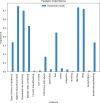Empowering child health: Harnessing machine learning to predict acute respiratory infections in Ethiopian under-fives using demographic and health survey insights
- PMID: 38515014
- PMCID: PMC10956296
- DOI: 10.1186/s12879-024-09195-2
Empowering child health: Harnessing machine learning to predict acute respiratory infections in Ethiopian under-fives using demographic and health survey insights
Abstract
Background: A dearth of studies showed that infectious diseases cause the majority of deaths among under-five children. Worldwide, Acute Respiratory Infection (ARI) continues to be the second most frequent cause of illness and mortality among children under the age of five. The paramount disease burden in developing nations, including Ethiopia, is still ARI.
Objective: This study aims to determine the magnitude and predictors of ARI among under-five children in Ethiopia using used state of the art machine learning algorithms.
Methods: Data for this study were derived from the 2016 Ethiopian Demographic and Health Survey. To predict the determinants of acute respiratory infections, we performed several experiments on ten machine learning algorithms (random forests, decision trees, support vector machines, Naïve Bayes, and K-nearest neighbors, Lasso regression, GBoost, XGboost), including one classic logistic regression model and an ensemble of the best performing models. The prediction ability of each machine-learning model was assessed using receiver operating characteristic curves, precision-recall curves, and classification metrics.
Results: The total ARI prevalence rate among 9501 under-five children in Ethiopia was 7.2%, according to the findings of the study. The overall performance of the ensemble model of SVM, GBoost, and XGBoost showed an improved performance in classifying ARI cases with an accuracy of 86%, a sensitivity of 84.6%, and an AUC-ROC of 0.87. The highest performing predictive model (the ensemble model) showed that the child's age, history of diarrhea, wealth index, type of toilet, mother's educational level, number of living children, mother's occupation, and type of fuel they used were an important predicting factor for acute respiratory infection among under-five children.
Conclusion: The intricate web of factors contributing to ARI among under-five children was identified using an advanced machine learning algorithm. The child's age, history of diarrhea, wealth index, and type of toilet were among the top factors identified using the ensemble model that registered a performance of 86% accuracy. This study stands as a testament to the potential of advanced data-driven methodologies in unraveling the complexities of ARI in low-income settings.
Keywords: Acute respiratory infection; Artificial intelligence; Ethiopia; FAIR; Machine learning.
© 2024. The Author(s).
Conflict of interest statement
The authors declare no competing interests.
Figures






Similar articles
-
Prediction of acute respiratory infections using machine learning techniques in Amhara Region, Ethiopia.Sci Rep. 2024 Nov 14;14(1):27968. doi: 10.1038/s41598-024-76847-3. Sci Rep. 2024. PMID: 39543232 Free PMC article.
-
Bayesian multilevel analysis of determinants of acute respiratory infection in children under the age of five years in Ethiopia.BMC Pediatr. 2022 Mar 10;22(1):123. doi: 10.1186/s12887-022-03187-4. BMC Pediatr. 2022. PMID: 35272658 Free PMC article.
-
Identifying determinants of malnutrition in under-five children in Bangladesh: insights from the BDHS-2022 cross-sectional study.Sci Rep. 2025 Apr 24;15(1):14336. doi: 10.1038/s41598-025-99288-y. Sci Rep. 2025. PMID: 40274916 Free PMC article.
-
Biomass fuel use and acute respiratory infection among children younger than 5 years in Ethiopia: a systematic review and meta-analysis.Public Health. 2021 Apr;193:29-40. doi: 10.1016/j.puhe.2020.12.016. Epub 2021 Mar 10. Public Health. 2021. PMID: 33713984
-
Predicting Major Adverse Cardiovascular Events in Acute Coronary Syndrome: A Scoping Review of Machine Learning Approaches.Appl Clin Inform. 2022 May;13(3):720-740. doi: 10.1055/a-1863-1589. Epub 2022 May 26. Appl Clin Inform. 2022. PMID: 35617971 Free PMC article.
Cited by
-
Machine Learning and Artificial Intelligence for Infectious Disease Surveillance, Diagnosis, and Prognosis.Viruses. 2025 Jun 23;17(7):882. doi: 10.3390/v17070882. Viruses. 2025. PMID: 40733500 Free PMC article. Review.
-
Predicting total healthcare demand using machine learning: separate and combined analysis of predisposing, enabling, and need factors.BMC Health Serv Res. 2025 Mar 12;25(1):366. doi: 10.1186/s12913-025-12502-5. BMC Health Serv Res. 2025. PMID: 40075408 Free PMC article.
-
Data-driven machine learning algorithm model for pneumonia prediction and determinant factor stratification among children aged 6-23 months in Ethiopia.BMC Infect Dis. 2025 May 2;25(1):647. doi: 10.1186/s12879-025-10916-4. BMC Infect Dis. 2025. PMID: 40316929 Free PMC article.
References
-
- World Health Organization. world-health-statistics-2015.pdf [Internet]. Available from: https://www.who.int/docs/default-source/gho-documents/world-health-stati....
-
- Young M, Wolfheim C, Marsh DR, Hammamy D. World Health Organization/United Nations children’s fund joint statement on integrated community case management: an equity-focused strategy to improve access to essential treatment services for children. Am J Trop Med Hyg. 2012;87(5 Suppl):6. doi: 10.4269/ajtmh.2012.12-0221. - DOI - PMC - PubMed
MeSH terms
LinkOut - more resources
Full Text Sources
Medical

